The Murrells
Following the 6-day course on Vertrouwen, Rita and I (with Bruce and Anne) headed up north to Cambrai to do a 2-day course with Tam and Di Murrell, and then to sit for our ICC (International Certificate of Competence) exam.
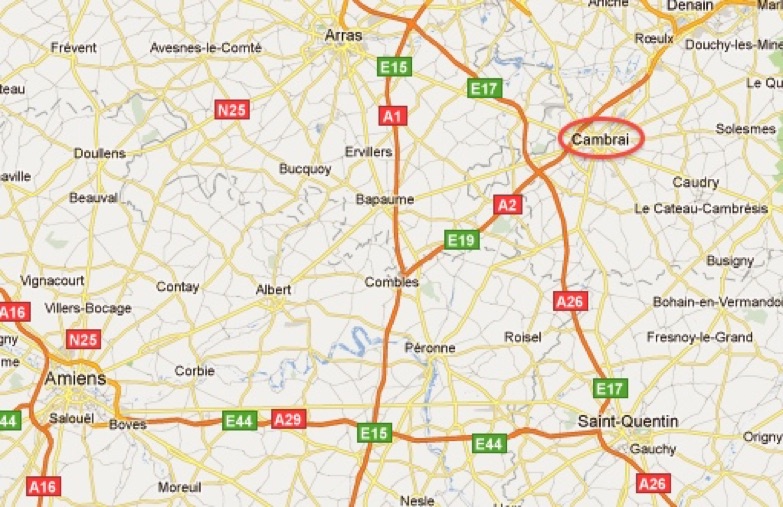
The course was run on their barge, Friesland, a 24m Beurtschip built in the Netherlands in 1922, and converted to a pleasure cruising barge in the UK from 1987 onwards. She has a 6L Gardner diesel engine, and has a bowthruster installed (although we were instructed to use it only when absolutely required - for most of the time it was turned off!).
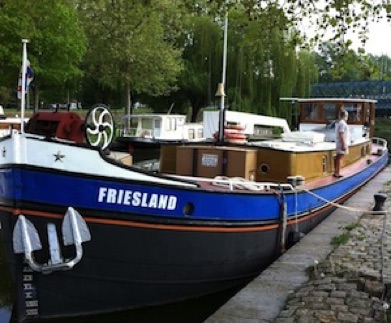
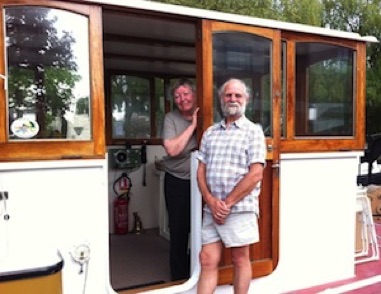
Tam and Di Murrell are an interesting couple, with a long family history in barging, having owned and operated many commercial craft from freight carrying narrowboats, barges and tugs on UK inland waters through to small coasters trading in and around the Thames estuary, North Sea and European mainland. They thus brought a wealth of practical knowledge to the course.
Tam took care of the skipper-in-training at the wheel, while Di instructed the deck-hand in the skills of rope-handling. This division of labour was very useful in that each was "master of their own domain". On the one occasion when they both tried to tell us how to tie up to a finger-wharf, we could see that even the most experienced of bargees can get into heated disagreements on occasion (which was reassuring to both couples, who had wondered how they would cope with the inevitable difference of opinion on our own boats).
The Murrell's course was organised very differently from the Vertrouwen course. Firstly, there were only four students on board (instead of six). Secondly, it was not live-aboard, and was basically a 9-to-5 course for two days. Each day, we went up the Saint-Quentin canal for several locks, then turned around and came back down the same locks. Then we retired to our hotel rooms. Thirdly, one of the questions we had after the Vertrouwen course was "how will we manage all this with just the two of us?" This was answered in the Murrell's course by having each couple work as a team, while the other couple simply observed. This gave us greater confidence in our ability to handle everything when we were by ourselves on our own barges. Fourthly, even though the second couple was just "observing", there was still a lot to learn, and so we took far fewer photos per day than when we where on Vertrouwen. Hence the relative absence of photos in this description of the course.
There was also a marked difference in the way that Di taught us to handle the ropes, as compared to what we learnt on Vertrouwen, or what we had separately learned in some lessons we took with Iain Noble at Moissac. On Vertrouwen, perhaps because there were so many crew on board, we almost always dropped someone ashore before each lock, especially on ascending locks, and they then walked to the next lock to catch the rope thrown from the boat. They then looped it around a bollard, and threw the rope back on board, where it was then tied (held fast) to an on-board bollard. They then repeated the process at the other end of the boat, then pushed the button on the dock to start the locking procedure in motion. In a descending lock, they then stepped back on board, or in an ascending lock they waited until the barge had risen before stepping on board.

On Friesland, however, Di was insistent that the bollard on the dock be "lassoed" with the eye of the rope (the loop at the end) from the crew on-board, and then tied to the bollard on-board. Di gives comprehensive instructions for how to do this (theoretically) on their DVD "Barge Handling in France".
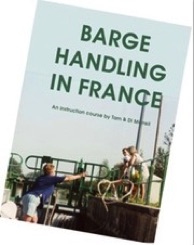
Then, either the deckhand or the skipper would lift the blue handle (the tirette) on the side of the dock to start the locking procedure in motion (NB: don't over-balance and grab the red handle by mistake to steady yourself - this shuts down the entire system, necessitating a visit by the nearest eclusier). At the completion of this process, when the barge had either risen or fallen completely, the deckhand then "flipped" the eye off the bollard.
All of this procedure was done with just a single rope at the bow, with the skipper using the rudder and idle-forward to keep the stern in place. This assumes that the eclusier would allow "single-roping", which we have observed to not be the case in many locks.
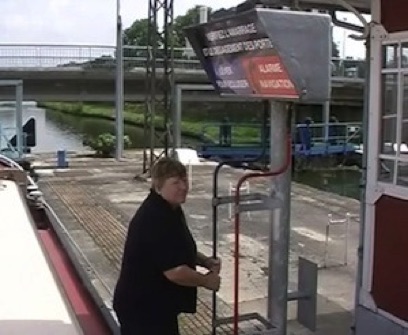
A different procedure was taught to us by Iain Noble at Moissac (also an RYA accredited trainer). He favoured the use of the "hallelujah" method, whereby a loop of rope (not an eye) was thrown over the bollard. The eye was already secured to one bollard on the barge, and once the rope was over the dock bollard, the other end (which was held under your foot while the loop was being thrown) was then secured to the second bollard on the barge. This had the advantage that the strain of holding the barge was spread across two lengths of rope. When it came time to release the rope, it could either be flipped over the dock bollard or, failing that, it could simply be pulled around the dock bollard (after untieing it from the barge bollard). This method, with the eye already attached to the barge bollard was also useful when using "sliders" in the lock. Iain also recommended using bow and stern ropes (with the engine in neutral, or turned off, and the skipper holding the stern rope), as a more secure way of controlling the forward and backward movement of the barge, especially in ascending locks where the water inflow can sometimes be very turbulent. This two-rope system was also required by many eclusiers on the Midi, before they would allow us to proceed.
The Murrells were very insistent that the crew should never leave the boat when in a lock. However, this directive and the use of the lasso technique only really works in a canal such as the Saint Quentin, where the presence of tirettes allows the locking process to be started from on-board. On the Midi and the Garonne, for example, it is necessary to get off the boat in order to push the button which starts the locking process. Also, the use of the double ropes (out and back) at both bow and stern seems to us to be a more secure system. But, to each their own!
One of the things that we did learn with the Murrells, that we hadn't seen elsewhere, was what to do when encountering a large peniche in a relatively narrow canal. Because the Saint-Quentin still carries a reasonable amount of freight barges, such occurrences were fairly frequent there. The first time you see one of these approaching in the distance can be somewhat intimidating. How on earth will we both get past each other?
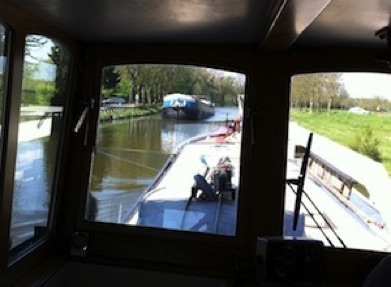
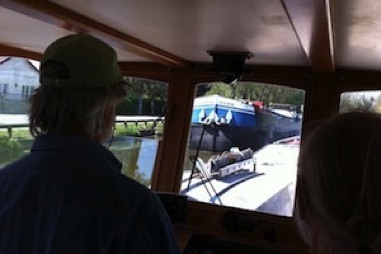
When they get up close they look even larger! However, Tam's excellent table-top explanations (using model boats and Ikea pencils!) of what happens in such a situation was very useful. Bearing these lessons in mind (and believing that they would actually work in the real world) was of great benefit in negotiating the passing manoeuvre. No longer were you quite as worried when the peniche skipper seemed not to want to move over to his side of the canal till the last moment.
For an action view of what happens in the passing manoeuvre, check out the video below.
After eight days of training in the two courses, Rita and I (and Bruce and Anne) were thrilled to get our ICC licences after passing the exams with flying colours. Now the fun begins, as we put it all into practice on our own over the next few years.
Thanks Jerry, Tam and Di
